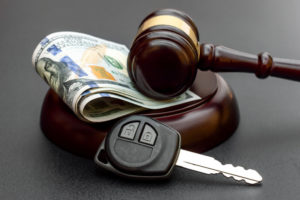Each year, thousands of people suffer serious injuries due to a car accident caused by another driver’s reckless or careless actions. In the violence of a car crash, it is common for drivers to become injured and their passengers as well.
If a car accident caused by another driver’s negligence injured you as a passenger, you could seek compensation with the help of a car accident attorney. Here is a look at what passengers in car accidents can recover through the personal injury claims process.
How to Determine Coverage in a Car Accident
All drivers who operate vehicles on public roadways owe a duty of care to other roadway users. This duty requires the driver to take reasonable actions to avoid causing harm to others. These actions generally include operating the vehicle safely and legally. One of the drivers’ legal requirements is maintaining the minimum insurance required by state law.
For example, in New York, for a driver to register their vehicle, they must show that they have the following minimum insurance coverages:
- $10,000 in property damage for a single incident. This is how much money is available to help those who suffered harm due to the at-fault driver’s negligence to recover for the repair or replacement of their vehicle and other personal items damaged in the crash.
- $25,000 for one person injured in the accident, or $50,000 for the death of one person in the accident
- $50,000 for bodily injuries or $100,000 for the deaths of two or more people in the accident
While these amounts are the minimum insurance required to register a vehicle in the state, the vehicle’s owner can obtain additional coverage. However, the amount of coverage their policy lists per person, per accident, is known as the policy limits and generally is the maximum compensation available to personal injury claimants. However, if the accident involved negligence on the part of more than one insured party, additional compensation may be available; you can file claims against the liability policies of any other driver with fault in the accident.
Depending on the type of insurance held by the driver of the vehicle the injured party was riding in, the passenger can even seek compensation from their own driver’s insurance in some cases.
If the driver has personal injury protection (PIP) coverage, the wage loss and medical benefits provided by this policy can extend to household members of the insured and anyone who rode in their vehicle, regardless of fault. If a passenger is injured due to the driver’s negligence, they can seek compensation through the driver’s bodily injury liability coverage.
Coverage of medical expenses can also be sought through coverages such as medical payments policies, the injured passenger’s health insurance coverage, or even an uninsured/underinsured motorist policy held by the driver of the vehicle the passenger was riding in if an at-fault driver did not have insurance coverage to compensate the claim.
Expenses Passengers Can Recover
Car accident injuries can result in profound financial and psychological costs. Some of the costs after an accident include income and productivity losses, medical expenses, administrative expenses, vehicles damage, and an employer’s uninsured costs.
The average economic costs associated with car accidents per death, injury, or vehicle involved are:
- Property damage-only accidents: $4,700
- Accidents in which no injuries were observed: $12,800
- Accidents involving possible injuries: $23,900
- Accidents featuring evident injuries: $29,200
- Accidents involving disabling injuries: $101,000
- Accidents involving death: $1,750,000
It is important to understand, however, that financial costs are not the only impact drivers and passengers suffer when they’re injured in an accident. The injury can also negatively impact their quality of life, and compensation can also be sought for those impacts.
When anyone is injured on a public roadway due to another driver’s negligence, they have a right to seek compensation for their injuries through the personal injury claims process. This process involves seeking compensation by filing a claim against a relevant policy held either by the at-fault party or by a driver who has obtained required or optional coverages.
The compensation that an injured passenger can seek includes:
- Economic damages, which involve compensation for the expenses incurred by the passenger as a result of the accident. These expenses include the cost of all reasonable costs associated with medically treating injuries sustained in an accident, such as the cost of hospitalization, the services of physicians and surgeons, X-rays and other diagnostic tests, prescription medication, and even the costs of a placement in a long-term skilled nursing or rehabilitation facility. Other costs incurred by passengers injured in a car accident include repairing or replacing their damaged property—such as a broken phone—and the wage loss associated with missing work while recovering from the injury. If a passenger incurs permanent injuries due to the accident, they can seek compensation for the wages they will likely lose in the future.
- Non-economic damages, which involve compensation for the psychological impacts that were incurred by the passenger due to the trauma of the accident and the injuries they sustained. Examples of the types of impacts passengers in car accidents can seek include physical pain and suffering, emotional distress, and loss of enjoyment of life.

How a Car Accident Attorney Values the Client’s Claim
When a passenger is injured in a car accident and hires an experienced personal injury attorney to help them as they seek compensation through the personal injury claims process, one of the important services that an attorney can provide is a valuation of the client’s claim.
The reason it is so difficult to determine an average cost of a settlement or a court verdict for a car accident case is that there are so many factors that can affect not only the value of the claim but ultimately the value of the settlement or verdict as well, such as:
- The amount of insurance the at-fault party has. As noted, liability insurance policies have policy limits, which feature the maximum compensation the insurance provider is willing to provide for a claim made on the policy. Insurance is how most car accident claims are compensated, as few drivers can afford to pay the expenses of injuries sustained in a crash out-of-pocket. Remember, bodily injury policy limits feature not only a maximum amount that the insurance company will pay out per injury but also per accident if multiple parties are injured due to the driver’s carelessness or recklessness.
- The clarity of liability. If the evidence can establish that one party was liable for the accident, it is generally easier to obtain compensation than when liability is disputed.
- The severity of the injury. More severe injuries typically drive up the claim’s value. They often result in the need for more serious medical treatments, a longer period when the injured party is unable to work due to the injury, and even a higher likelihood of permanent disabilities arising from the injury that will impair the claimant’s future earning capacity.
An attorney will generally value a claim based on a formula that can account for the significant psychological impacts incurred as a result of the injury.
This formula generally looks something like this:
- The attorney will gather the documentation of expenses, such as bills for services, receipts, and wage loss information. Add these expenses to a total economic damage claim.
- Multiply the total economic damages by a number to determine the non-economic losses. The more severe the injuries, the higher the multiplier used.
- Add the economic and non-economic damages for an overall value of the claim.
Will the Insurance Company Pay the Full Value of the Claim?
The claim’s value is the amount requested by the at-fault party’s insurance provider. When the provider receives your claim, they will assign a claims adjuster to evaluate the accident and injury circumstances.
They will determine three things:
- Did their insured cause the accident?
- Does the insured’s policy cover the damage?
- How much compensation does the claimant deserve?
Once the claim’s adjuster’s determination has been made, they are ready to decide on the claim. They can either choose to approve the claim and pay the amount requested, deny the claim and provide a reason for the denial or offer to settle the claim out of court for less than its established value.
It is important to understand that the insurance claims adjuster’s mission in evaluating the claim is in direct opposition to the mission of the injured passenger in filing the claim. While you’re looking to obtain the maximum amount of compensation available for the harm you experienced due to the driver’s negligence, the insurance company looks to limit the amount they have to pay you for the claim. Because of this, many car accident claimants are surprised when the insurance company offers a settlement on the claim far below the value their attorney established for it.
When the settlement is too low to compensate the claim fairly, the claimant’s attorney can negotiate with the adjuster to get them to increase their offer. They can also file a personal injury lawsuit, a legal request filed in civil court that asks the court to appoint a judge or jury to hear the case, determine if liability has been proven, and—if so—how much money is owed to the claimant.
How an Attorney Protects the Claim’s Value During a Personal Injury Case

Car Accident Lawyer, Andrew Finkelstein
In addition to properly valuing the claim to account for all of the financial and psychological impacts that the injured passenger experienced as a result of the at-fault driver’s liability, there are several services that an attorney provides to protect the value of the claim.
Those services include:
- Managing communication with the at-fault party’s insurer. Insurance claims adjusters commonly use questionable tactics to convince claimants that their claim is not worth as much as they think. A skilled attorney understands these tactics and can prevent them from damaging the claim’s value.
- Filing a lawsuit within the statute of limitations for such claims. The statute of limitations is a legal deadline on the claimant’s ability to file a lawsuit. For example, in New York, individuals injured in car accidents caused by another’s negligence typically have three years from the date of the injury to file a car accident lawsuit. Many personal injury claimants shrug off this deadline, believing that their claim will settle out of court, so there is no need for a lawsuit to be filed. However, allowing the statute of limitations to expire not only results in the loss of the ability to file a lawsuit in most cases but also frees the insurance company from the legal requirement to settle the claim.
- Gathering the evidence and witness testimony to prove liability and justify the claim’s value. Evidence to prove liability can include video surveillance footage, eyewitness and expert witness testimony, and photos of injuries and damage. Evidence needed to show the claim’s value includes bills, receipts, wage information, and testimony from family and friends about how the accident has impacted your day-to-day life.
- Guiding the claimant so they know when they receive an offer for fair compensation.
If an accident injured you, contact a car accident lawyer near you for a free case evaluation and let us help you understand your legal options.
